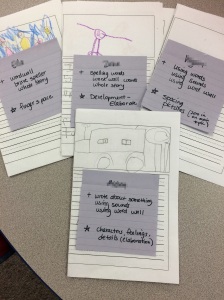I recently sat down with the kindergarten teacher to analyze her students’ narrative writing. With two half-day classes of kindergarteners, there was a lot of writing. Their little books covered the table. We had fifty blank copies of the kindergarten narrative rubric in front of us, but the task of scoring each one felt overwhelming. We were feeling the pressure of parent-teacher conferences and report cards lurking just around the corner. We wanted to analyze the writing thoroughly, yet efficiently. I had an idea. All we needed was a copy of the rubric and an earlier sample of writing.
First, we read through the narrative writing rubric. We underlined key terms and circled the things we felt were most important. We knew it was important to ground our work in the rubric.
Next, the kindergarten teacher found her stack of writing samples from the beginning of the year. For each student, we placed the earlier sample side-by-side with this most recent sample. Using the rubric as a guide, we noted what each student was able to do now that they could not do previously.

For example, you can see in the photo that the student in the left corner is now using the word wall and brave spelling. This student is also able to tell a whole story across pages.
For each student we also identified a next instructional step (again, using the rubric to guide us). That same student could benefit from using finger spaces to separate her words. The student in the bottom of the photo is ready to develop characters by adding feelings.
The teacher and I thought this was a quick yet effective way to look through the samples of student writing. It provided useful information for each student and gave us something substantial to share with parents during conferences.
Next time we meet, we will use the Post-It notes to form small groups for instruction. We already noted several students who need guidance with spacing, as well as a couple of students who are ready to elaborate by writing more.
We did not score each piece of writing individually using the rubric, but we did focus on what matters – the students, their strengths, and next steps.


Great idea for the students to see their own growth!
LikeLike
This is a great strategy! My 7th grade students just finished the second district writing test for the year, and I was trying to think of a way to make this necessary assignment more valuable. I think I will have my students review their Fall writing assessment to this assessment themselves; hopefully I can guide them to reflect on their own writing to see how much they have improved. And, this is just in time, since conferences are in one month! They will be able to share with their parents their growth.
LikeLike
Thank you! We have never tried this before, and I think it will make scoring the post-prompt more efficient!
LikeLike
I have the writing, I have the rubrics. Why didn’t I think of placing them side by side to show parents their child’s growth? I will now!
LikeLike
I’m going to try this with my 6th grade class. I like that it will show areas of strength and growth and areas for improvement. It has more meaning for parents than just a number on a rubric.
LikeLike
This is also more tangible for the parents to see where their child started and where they still need to grow. Providing a brief list of how the parents can help at home keeps them involved in the process and gives the parent and child a nice way to engage together in writing!
LikeLike
I have a stack of student writing on my table at home and know how daunting that can be. Your approach seems both efficient and effective–Win! Win! Thanks for sharing.
LikeLike